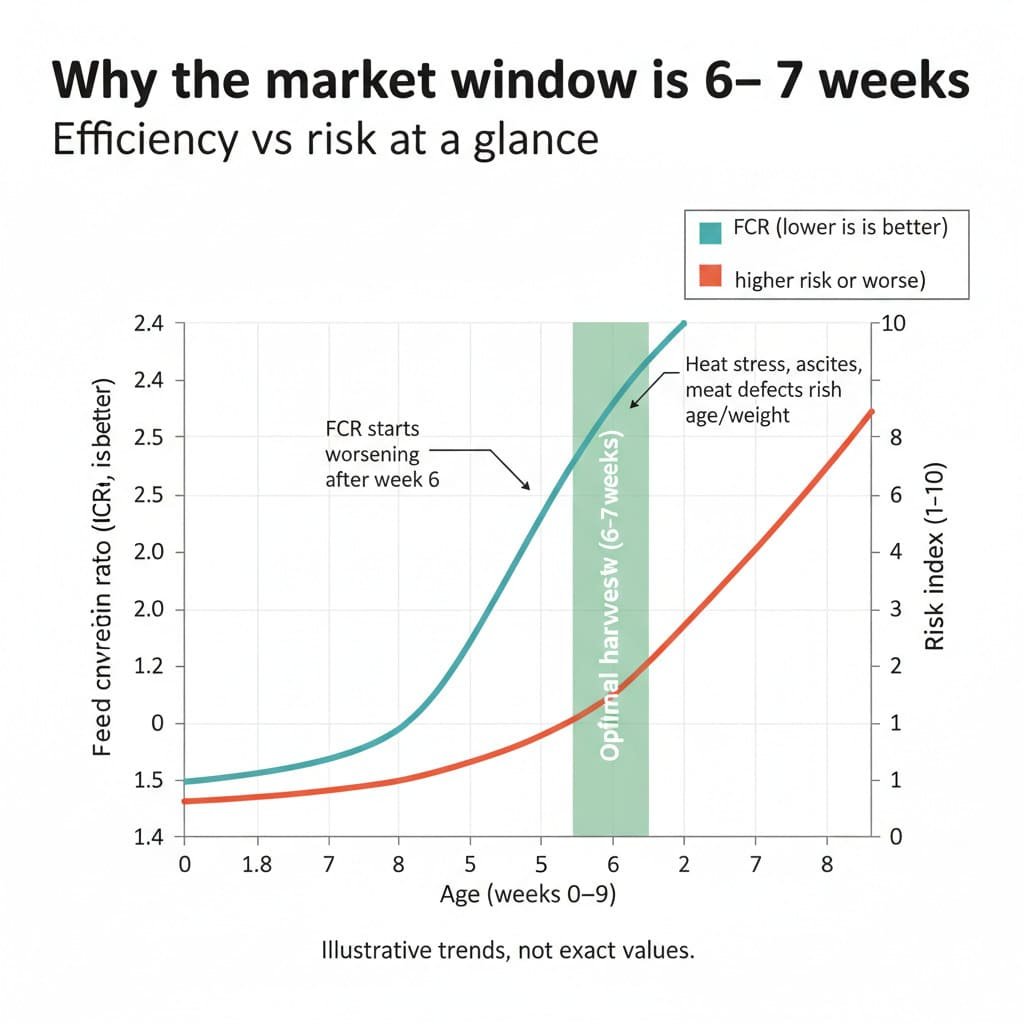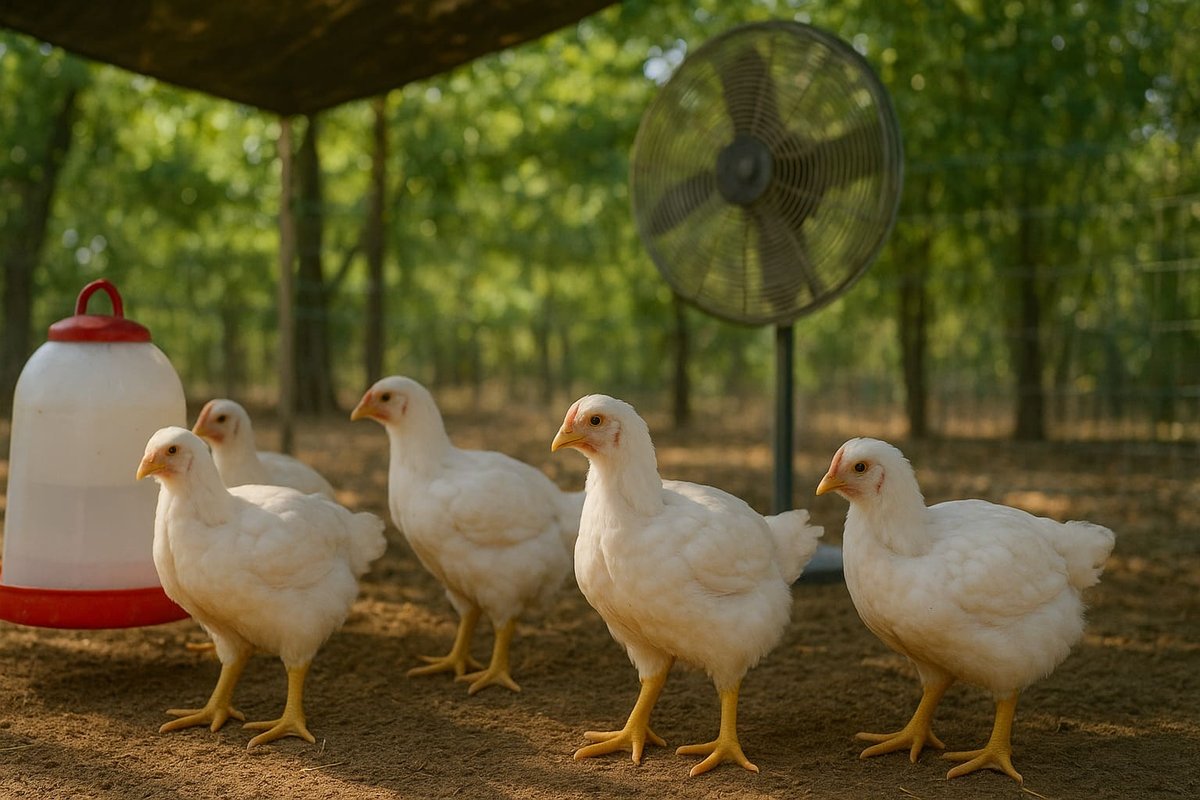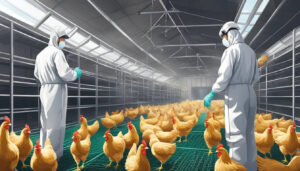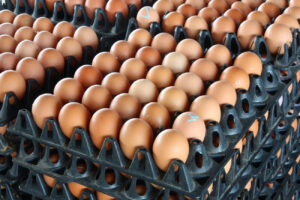Raising broiler chickens is a rewarding experience, but timing is everything. A common question for new keepers is why broilers are typically processed around the 6-week mark. The answer is a critical balance of the bird’s health, feed efficiency, and final meat quality. This guide explains the critical reasons why should Broilers not be kept longer than 6 weeks. We will cover everything from ideal market age and target weights to common health issues and how to provide the best care for your flock.
This guide, authored by Oladepo Babatunde, a backyard chicken keeper and educator, combines years of hands-on experience with information gathered from extensive research and cited industry sources. It is designed to help beginners raise healthy flocks by understanding the critical balance of health, efficiency, and meat quality.
Quick Answer: Why should broilers not be kept longer than 6 weeks?

Broilers should not be kept longer than 6 weeks because their feed efficiency declines, their health risks from rapid growth increase, and the quality of their meat can degrade.
Most broilers are harvested around 6–7 weeks because feed efficiency declines sharply with age, meaning they eat more food for every pound of weight they gain. This is also why costs rise after week 6–7; use our feed calculator to model your batch. Furthermore, older and heavier birds often develop breast meat defects like “woody breast,” which reduces the quality and value of the meat. In the U.S., the average market age is about 47 days, according to the National Chicken Council.
Broiler Life Cycle (week by week): why 6–7 weeks is the optimal endpoint
From hatch to market in about six to seven weeks, broilers pass through rapid growth phases where feed efficiency is highest early and welfare risks climb later—another reason why broilers should not be kept longer than 6 weeks.
Week 0–1 (Days 1–7): Brooding and early gains
- Goals: Warm, dry, draft‑free brooder; constant clean water; starter feed.
- Environment: 32–35°C (90–95°F) at chick level; reduce heat if panting, increase if huddling.
- Feed: Broiler starter (follow label protein/energy); small feeders with easy water access.
- Watch for: Pasty butt, chilling/overheating, dehydration.
Related reading:
Weeks 2–3 (Days 8–21): Rapid growth phase
- Environment: Step down ~5°F weekly; target 27–29°C (80–85°F) by end of week 3; strong ventilation without drafts.
- Feed: Starter → grower per label.
- Management: Increase space; keep litter dry; raise drinkers to back height.
- Risks: Early coccidiosis; ammonia irritation if litter is wet.
Related reading:
Weeks 4–5 (Days 22–35): Efficiency peak; heat sensitivity rises
- Environment: 24–27°C (75–80°F) with steady airflow at bird height; provide shade in hot climates.
- Feed: Grower; adjust feeder height; avoid spilled/wet feed.
- Management: Reduce density; add evening/early‑morning feeding in heat.
- Risks: Heat stress begins to appear; leg strain in heavier birds.
Related reading:
Weeks 6–7 (Days 36–49): Market window
- Why this window: After week 6–7, feed conversion worsens and risks rise (heat stress, ascites/SDS, leg problems; meat quality defects like white striping/woody breast).
- Feed: Grower → finisher per label; plan 8–12 hours feed withdrawal before processing—never withhold water.
- Management: Gentle handling; strong shade/airflow; schedule processing or transport during the coolest hours.
Related reading:
8+ weeks (optional): Why “keeping longer” costs more and risks more
- What changes: Poor FCR, higher mortality risk, more trimming/quality issues; welfare concerns escalate.
- Recommendation: If you truly need larger birds, plan for it early; otherwise, harvest in the 6–7 week window.
Broiler life‑cycle planner
| Age | Target house temp at bird level | Feed phase | Typical live weight | Key risks | Actions |
|---|---|---|---|---|---|
| 0–1 wk | 32–35°C (90–95°F) | Starter | ~0.15–0.25 kg (0.3–0.6 lb) | Chilling/overheat, dehydration | Warm, dry brooder; easy water; check vents |
| 2–3 wk | 27–29°C (80–85°F) | Starter → Grower | ~0.6–1.2 kg (1.3–2.6 lb) | Coccidiosis, ammonia | Dry litter; raise drinkers; good airflow |
| 4–5 wk | 24–27°C (75–80°F) | Grower | ~1.6–2.2 kg (3.5–4.9 lb) | Heat stress, leg strain | Shade, fans, density relief; cool‑hour feeding |
| 6–7 wk | 21–24°C (70–75°F) | Finisher (per label) | ~2.3–3.0 kg (5.1–6.6 lb) | Heat stress, ascites/SDS, meat myopathies | Schedule processing; water always; 8–12 h feed withdrawal |
| 8+ wk | Ambient as safe | — | 3.2 kg+ (7.0 lb+) | Poor FCR, welfare/quality decline | Generally not recommended |
Notes
- Adjust temperatures using behavior cues (panting/huddling), as backyard setups vary.
- Keep “complete broiler feed” as the baseline; avoid heavy scratch that dilutes protein/energy.
- If you keep broilers as pets, use a vet‑guided restricted plan and monitor weight weekly.
Broilers Dying at 6 Weeks: Common Causes and What to Check
Common causes of death for broilers around 6 weeks are heat stress, rapid-growth disorders like ascites and sudden death syndrome, and a higher risk of skeletal problems.
The 5 to 7-week period is when broilers are largest and most vulnerable. Their rapid growth puts immense strain on their bodies, making them susceptible to several issues. If you are experiencing losses, here are the most common culprits.
Heat Stress and Dehydration
At this age, a broiler’s large muscle mass and high metabolism generate significant body heat. They struggle to cool down, especially in temperatures above 80–85∘F (27–29∘C), as noted by university extensions. Poor ventilation is a frequent driver; correct airflow at bird height is critical.
- Signs: Heavy panting, holding wings away from their bodies, lethargy, pale combs, and lying down with their neck extended.
- Fixes: Ensure constant access to cool, fresh water. Provide ample shade and ventilation; a simple box fan can make a big difference in a small coop. Add poultry electrolytes to the water during heatwaves to replenish lost minerals. During the hottest part of the day, you can briefly withdraw feed, as digestion generates extra body heat, but never restrict water. For more information, see our guide on what to feed chickens during a heatwave.
Hot Climate Checks
- Coop Temperature: Measure the temperature and humidity at bird height to understand the environment.
- Ammonia: Keep ammonia levels below 25 ppm (a rule of thumb is if it stings your eyes or smells sharp, add litter and ventilate).
- Deep Shade: Ensure birds can get out of direct sun all day by learning the best place to put your chicken coop. It is also important to know if chickens can get sunburned.
- Good Airflow: Use tunnel ventilation or fans to keep air moving at bird level.
- Cool Water: Use larger waterers and change the water frequently to keep it cool.
- Night Feeding: Encourage birds to eat during cooler nighttime hours.
- Lower Stocking Density: Give each bird more space to reduce collective body heat.
Rapid-Growth Disorders
Modern broiler strains like the Cobb 500 and Ross 308 are bred for incredibly fast growth, which can sometimes outpace their heart and skeletal development. The Merck Vet Manual and eXtension confirm that core medical risks at heavier ages include ascites/pulmonary hypertension, Sudden Death Syndrome (SDS), and leg disorders. If you see your chicken acting lethargic, here’s what to look for.
- Ascites (Water Belly): This metabolic disorder is a form of cardiovascular dysfunction where the heart and lungs cannot support the body’s rapid growth, leading to fluid buildup in the abdomen. The bird may have a swollen, water-balloon-like belly and difficulty breathing.
- Sudden Death Syndrome (Flip-Over Disease): Seemingly healthy, large birds may die suddenly from metabolic heart failure, often found on their backs. This is another direct consequence of their extreme growth genetics.
- Skeletal Problems: The bird’s heavy weight can overwhelm its still-developing skeleton, leading to painful conditions like angular bone deformities and tibial dyschondroplasia, where cartilage in the leg fails to ossify properly. This is a significant welfare concern.
- If you see persistent labored breathing, repeated collapse, or non-weight-bearing lameness, call a vet immediately.
Disease Basics and Biosecurity
Fast-growing broilers have a higher late-cycle mortality risk than layer-type pullets; good ventilation and hygiene reduce this risk. The best defense is good biosecurity: keep the coop clean and dry, manage litter to prevent high ammonia levels that cause respiratory issues, prevent contact with wild birds, and provide clean food and water. Our guide on a chicken health check can help you catch issues early. For added safety, consider using a footbath or changing your boots before entering the coop.
Always quarantine new birds for at least 14 days and observe for any signs of illness before introducing them to your flock. If you suspect an illness, isolate the sick bird and contact a local poultry vet. For a more detailed guide on treating chicken respiratory infection, see our article. You can also review natural ways to keep parasites out of your coop. These mounting health risks are central to the decision to process broilers at a younger age. As we’ll see, the question of their maximum lifespan is very different from their optimal processing age.
How Long Can Broiler Chickens Live If You Keep Them?
If kept as pets, broiler chickens can potentially live for months or even a few years, but their genetics for rapid growth require strict management to prevent health issues and suffering.
While the commercial lifespan of a broiler is about 4 to 7 weeks, they can potentially live for months or even a few years if kept as pets. However, this requires strict management and presents significant ethical challenges. For more context on how long chickens live, see our full guide. Their genetics for rapid growth put them at high risk for painful leg problems, obesity, and heart failure as they age. To keep a broiler long-term, you would need to implement a strict, low-calorie diet to slow their growth, which contradicts their fundamental genetics.
Even with perfect care, they are prone to a lower quality of life. This starkly illustrates why broilers should not be kept longer than 6 weeks in a production setting, as their welfare dramatically declines with age. The practicalities of cost and meat quality further reinforce the importance of timing. Let’s explore the ideal window for processing your birds.
If Kept as Pets: A Checklist
- Controlled Feed Plan: Consult a vet to develop a restricted-calorie feed plan.
- Weekly Weight Checks: Monitor weight weekly to ensure slow, healthy growth.
- Body-condition target: (keep keel bone palpable)
- Mobility Support: Provide ramps and low perches to make movement easier.
- Heat Management: Have a dedicated heat stress plan with shade and ventilation for warm weather.
How Long Can You Keep Broiler Chickens? (Practical Decision Guide)
The ideal time to process broiler chickens is typically between 5-6 weeks to achieve the best balance of feed efficiency, meat quality, and low health risks.
The ideal time to process your broilers depends on your goals for meat type and your tolerance for cost and risk. This is where the concept of Feed Conversion Ratio (FCR)—the amount of feed it takes to produce one pound of body weight—becomes critical. Typical FCR ranges from management guides from Aviagen Broiler Management Guide are as follows:
| Age (weeks) | Typical Live Weight | Product | Who It Suits | Notes |
|---|---|---|---|---|
| 5–6 | 2.3–2.7 kg (5.1–6.0 lb) | Fryer/Whole | Whole-bird buyers, home keepers | Best FCR, tender meat, lower risk |
| 7–8 | 3.0–3.4 kg (6.6–7.5 lb) | Roaster/Parts | Processing for parts, large families | Higher feed cost; ↑ heat stress, myopathies |
| 8+ | 3.6–4.0 kg+ (7.9–8.8 lb) | Heavy Roaster | Niche markets with specific demand | Poor FCR; ↑ mortality; welfare concerns |
To ensure your birds are getting the right nutrients, see our comprehensive guide to feeding your chickens and our article on the best feeding schedule for backyard chickens. Understanding this timeline helps explain some of the common terminology used in the poultry industry. For example, knowing the difference between feed and scratch is essential.
Meat Quality Issues: Wooden Breast and White Striping
These common myopathies are a direct result of the rapid growth of modern broilers; quality defects increase with age and weight, leading to trimming losses and texture issues that reduce yield and value. They do not pose a food safety risk but significantly impact the texture and value of the meat.
- Wooden Breast: This condition causes the breast meat to be unusually hard and firm, making it tough and chewy when cooked. The texture is similar to wood, hence the name.
- White Striping: Characterized by white, fatty-looking stripes running parallel to the muscle fibers. The affected meat has a higher fat content and a less desirable, tougher texture.
Why Is Chicken Called “45 Days”?
“45-day chicken” is an industry term because modern broilers are selectively bred to reach their ideal market weight in approximately 45 days.
“45-day chicken” is industry shorthand for modern broilers that are bred to reach their target market weight in approximately 45 days, or about 6 to 7 weeks. This rapid turnaround is the result of decades of selective breeding and highly optimized nutrition. The actual harvest age can vary by target weight and market (e.g., for chicken nuggets versus whole birds), but the U.S. industry average, according to the National Chicken Council (NCC), hovers around 47 days. This rapid growth translates to impressive weight gain in a very short period.
How Many kg Is a 6-Week Broiler Chicken?
A typical 6-week-old broiler chicken has a live weight of approximately 2.3–2.7 kg (5.1–6.0 lb).
At 6 weeks (42 days), a typical broiler flock will average a live weight of 2.3–2.7 kg (5.1–6.0 lb). This can vary depending on the specific strain (e.g., Ross 308 vs. Cobb 500), sex (males are often heavier), nutrition, and environmental conditions. For context, the U.S. average live weight at the typical market age of 47 days is approximately 2.97 kg (6.57 lb) according to the National Chicken Council.
Remember that the final carcass weight will be lower after processing, typically yielding a dressing percentage of around 70-75% based on data from the University of Wisconsin Extension. For example, a 2.6 kg live bird would yield an edible carcass of about 1.8–2.0 kg. You can estimate costs with a chicken feed calculator to hit your target weight. The relationship between age and weight is predictable and crucial for planning.
The Alternative: Slower-Growing Broiler Breeds
For farmers who prioritize animal welfare, slower-growing breeds offer a compelling alternative, reaching market weight with significantly fewer health and mobility issues.
While fast-growing commercial broilers typically gain around ~55–65 g/day, alternative breeds grow at a more moderate rate of around ~40–50 g/day. This slower growth allows their bones, heart, and organs to develop more proportionally with their body weight. As a result, they reach the same final market weight in a typical range of ~56–70 days instead of the commercial ~42–49 days, but with a drastically lower risk of painful skeletal and metabolic issues. Popular slower-growing breeds include the Freedom Ranger, Label Rouge, and various heritage breeds.
How long can you keep broiler chickens? and How Many Months Do Broilers Take to Mature?
Broilers can be eaten at various stages from 4 weeks as a small Cornish hen up to 8 weeks as a large roaster, but they reach market maturity in a few weeks, not months.
Broilers mature very quickly and can be eaten at various sizes. In this context, “maturity” refers to reaching a target market weight, not sexual maturity. Here is a general guide mapping age to weight and product type, based on data from organizations like the EFSA. Note that slower-growing and organic systems may go as long as 8–12 weeks by design. You can use our guide on how many bags of feed you’ll need to plan accordingly.
| Age (Days) | Age (Weeks) | Typical Live Weight | Common Product Type | Notes |
|---|---|---|---|---|
| 28–30 | 4 weeks | ~1.5 kg (3.3 lb) | Cornish Hen / Spatchcock | Very tender, smaller portions. |
| 38–42 | 5.5–6 weeks | ~2.5 kg (5.5 lb) | Fryer / Whole Bird | Optimal balance of size, feed efficiency, and meat quality. |
| 49–56 | 7–8 weeks | ~3.2 kg+ (7.0 lb) | Roaster / Large Parts | Higher feed cost, increased risk of woody breast and heat stress. |
| > 60 | 8.5+ weeks | ~4.0 kg+ (8.8 lb) | Heavy Roaster | Not recommended; poor efficiency and significant welfare/health risks. |
Proper management of their basic needs like food and water is essential throughout their short lives.
How Long Can Broilers Stay Without Food? Water?
Broiler chickens should never be without access to water, while feed is only withdrawn for a short period of 8-12 hours immediately before slaughter for food safety reasons.
This is a critical welfare question. For health and food safety, water should never be withheld from broiler chickens. They must have access to clean water at all times, as dehydration can happen rapidly, especially in hot weather. If you are bringing new birds home, our guide on must-haves for chicks has important tips on hydration equipment.
Feed withdrawal is only done for a limited period of 8–12 hours immediately before slaughter to ensure the digestive tract is empty, which is a key food safety step to prevent contamination during processing. If catching or transport will exceed 12 hours, coordinate water access at the destination immediately upon arrival. Knowing how to handle emergencies is just as important as daily care. It helps to set up a chicken first-aid kit at home.
How to Revive a Dying Broiler (Safe, Vet-First Triage)
To revive a dying broiler, gently move the bird to a cooler, shaded area and offer cool water, but always consult a veterinarian for professional guidance.
Disclaimer: These are emergency first-aid steps for heat stress or dehydration. Always consult a veterinarian for animal health issues. Do not administer medication without professional guidance. If you find a broiler collapsed, breathing heavily, or unresponsive on a hot day, act quickly:
- Move Gently: Immediately move the bird to a cooler, shaded, and well-ventilated area away from other birds.
- Offer Cool Water: Provide cool (not ice-cold) water. You can add a poultry electrolyte solution to help with recovery, following the label dosing carefully. Avoid sugar-only solutions in severe heat stress. For more information, see our guide on what to feed during a heatwave.
- Cool the Bird: You can gently mist the bird with cool water or dip its feet and legs in cool water to help lower its body temperature.
- Reduce Stress: Keep handling to a minimum. Let the bird rest quietly.
- Do Not Force-Feed or Submerge: Never try to force-feed a collapsed bird, as it can easily inhale the liquid (aspirate). Do not submerge the bird in cold water, which can cause shock. Avoid handling the neck/head during panting to reduce aspiration risk.
- Call a Vet: These steps can help in the short term, but professional veterinary advice is essential. For more detail, read our guide on when to call the vet.
For those just starting, buying birds at a later stage is an option.
6-Week Broilers For Sale: Buyer’s Checklist
When buying 6-week-old broilers, check for alertness and activity, ask about their health history, and ensure you have a clean, cool space ready for them.
If you are buying partially-grown broilers, this checklist will help you select healthy birds and get them settled safely.
- Health Check: Look for birds that are alert, active, and have clear eyes and nostrils. Avoid any that are lethargic or have ruffled feathers.
- Ask Questions: Inquire about the birds’ health history, what they have been fed, and their exact age.
- Safe Transport: Use a well-ventilated crate with clean bedding. Do not overcrowd it. Transport during the coolest part of the day.
- Arrival Care: Have a clean space ready with fresh food and, most importantly, cool, fresh water with electrolytes available immediately upon arrival.
- Know Local Laws: Be aware of any local regulations regarding the transport and processing of poultry. You can check our guide to chicken laws by state for more information.
- Quarantine: Isolate new arrivals for 10–14 days and observe for any unusual droppings or respiratory signs before introducing them to the main flock. Don’t forget to review your predator-proofing before introducing them to your coop.
This brings us back to the central question, summarizing all the risks involved.
Why Should Broilers Not Be Kept Longer Than 2 Months?
Broilers should not be kept past two months because doing so leads to poor feed conversion, a high risk of mortality, and a degraded meat quality.
Keeping broilers past 2 months (about 8 weeks) is strongly discouraged because it leads to diminishing returns and serious welfare problems. The key reasons are a convergence of economics, animal welfare, and product quality:
- Poor Feed Conversion: The amount of feed they need to eat to gain a pound of meat skyrockets, making it very expensive and unsustainable. You can see this in our breakdown of the cost to raise chickens.
- High Mortality Risk: The risk of death from heat stress, cardiovascular dysfunction, and skeletal failure increases daily as the birds get heavier.
- Degraded Meat Quality: The incidence of tough, chewy meat from conditions like white striping and woody breast becomes very high, making the final product less enjoyable. White striping and woody breast incidence increases with age/weight, producing tougher texture and lower yield. Ultimately, the entire system of raising modern broilers is designed around this 6-to-7-week endpoint.
Note: For farmers in Nigeria, a more specific guide on starting a profitable broiler farm is available.
FAQ (Frequently Asked Questions) on Why Should Broilers Not Be Kept Longer Than 6 Weeks
Below are the answers to some of the most common questions about raising broiler chickens.
How many weeks can broilers be eaten?
Broilers can be eaten from as early as 4 weeks (as Cornish hens) up to 8 weeks (as roasters), but the ideal time for the best balance of size and quality is between 5 and 7 weeks.
Why is chicken called 45 days?
This is an industry term because modern broiler breeds are designed to reach an ideal market weight in about 45 to 47 days. This timeframe is a key reason why broilers should not be kept longer than 6 weeks from a commercial perspective.
What is the typical weight of a 6-week broiler?
A 6-week-old broiler typically has a live weight between 2.3–2.7 kg (5.1–6.0 lb).
How long can broilers go without food and water?
Broilers must always have access to water. Feed is typically only withdrawn for 8-12 hours just before processing for food safety reasons.
Is it humane to keep broilers as pets?
It can be, but it requires dedicated care. Due to their genetics for rapid growth, they need a very strict, managed diet to prevent obesity, leg problems, and heart failure. It is a significant commitment that requires veterinary guidance.
Conclusion
This guide covers the core reasons why the 6-week window is so critical for raising broilers, from the economics of feed to the welfare of the bird. I hope this gives you a clear understanding of what’s involved in raising a healthy and productive flock.
If you have any more questions, such as how to design a broiler-specific coop or create a detailed feeding schedule for your flock, just ask!

Oladepo Babatunde is the founder of ChickenStarter.com. He is a backyard chicken keeper and educator who specializes in helping beginners raise healthy flocks, particularly in warm climates. His expertise comes from years of hands-on experience building coops, treating common chicken ailments, and solving flock management issues. His own happy hens are a testament to his methods, laying 25-30 eggs weekly.



